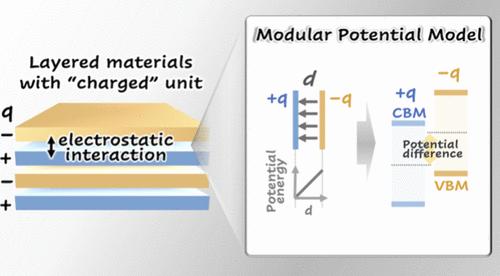模块化无机晶体中电子结构的静电控制
IF 15.6
1区 化学
Q1 CHEMISTRY, MULTIDISCIPLINARY
引用次数: 0
摘要
针对元素固体和简单化合物制定的结构和成键规则,在应用于由多原子构件(如层状或框架材料)形成的更复杂晶体时具有挑战性。这些模块构件是电中性还是带电,会影响晶体的物理性质。尽管交替带电单元非常普遍,但它们对电子结构的影响仍不清楚。我们展示了带电结构单元的分布如何在静电势差异的驱动下影响层状晶体中形成的电子带能。这个粗粒度模型预测了在金属氧卤化物 Ba2Bi3Nb2O11Cl 中观察到的空间分离的价带和导带边缘,并解释了在 Sillén-Aurivillius 晶体系统中观察到的性质趋势。此外,该模型的一般性质允许扩展到其他模块结构类型,如 Sillén 和 Ruddlesden-Popper 层状化合物,并可支持各种材料电子特性的合理设计。本文章由计算机程序翻译,如有差异,请以英文原文为准。

Electrostatic Control of Electronic Structure in Modular Inorganic Crystals
The rules that govern structure and bonding, established for elemental solids and simple compounds, are challenging to apply to more complex crystals formed of polyatomic building blocks, such as layered or framework materials. Whether these modular building blocks are electrically neutral or charged influences the physical properties of the resulting crystal. Despite the prevalence of alternating charged units, their effects on the electronic structure remain unclear. We demonstrate how the distribution of charged building blocks, driven by differences in the electrostatic potential, governs the electronic band energies formed in layered crystals. This coarse-grained model predicts the spatially separated valence and conduction band edges observed in the metal-oxyhalide Ba2Bi3Nb2O11Cl and explains observed property trends in the Sillén–Aurivillius crystal system. Moreover, the general nature of the model allows for extension to other modular structure types, illustrated for Sillén and Ruddlesden–Popper layered compounds, and can support the rational design of electronic properties in diverse materials.
求助全文
通过发布文献求助,成功后即可免费获取论文全文。
去求助
来源期刊
CiteScore
24.40
自引率
6.00%
发文量
2398
审稿时长
1.6 months
期刊介绍:
The flagship journal of the American Chemical Society, known as the Journal of the American Chemical Society (JACS), has been a prestigious publication since its establishment in 1879. It holds a preeminent position in the field of chemistry and related interdisciplinary sciences. JACS is committed to disseminating cutting-edge research papers, covering a wide range of topics, and encompasses approximately 19,000 pages of Articles, Communications, and Perspectives annually. With a weekly publication frequency, JACS plays a vital role in advancing the field of chemistry by providing essential research.

 求助内容:
求助内容: 应助结果提醒方式:
应助结果提醒方式:


